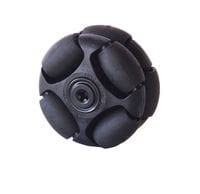While building George (and Bob) I learned quite a few things about building big moving Lego models. Don’t worry, I still have plenty to learn however I try to give quite a bit more thought to a project before I start prototyping and testing things out.
The main issue I always face is how do you make a huge model move! Now George and Bob both struggled on non slip carpets, however most surfaces were not a problem for them. As I plan to make my next project a lot bigger than the last 2, I instantly hit issues. Both George and Bob were quite thin models with a main long beam. George had a height of 5ft 7in. They both probably weigh between 20 and 25KG each. So imagine building something 6-8ft tall, with a main body 2 times fatter than George and a horizontal arm beam of around a meter long with a model of a mini gun on each end. Once built, if this things weighs less than 40KG I would be impressed!
For this next project I have given a lot of thought to the weight / moving issue. I have researched a few different options and the first one I hope to prototype is using Rotacaster omni-direction wheels to take the pressure off the tracks. These wheels can basically move in any direction and support up to 25kg per wheel!

Currently the omni-direction wheels only come in 48mm size which is a little small to use as the main platform, however if I keep with the normal track design but place these wheels behind the track to support the main body, which is the heavy part of the model, then the resistance on the tracks will be less and should then have an easier job moving the robot.
Lately I have also been investigating Lego compatible metal axles. Trying to transfer the power from several XL motors to the robots tracks is actually quite hard work because the motors are strong enough to twist plastic axles and snap cogs. They can also bend quite a bit when used as axles for the wheels / sprockets as they are supporting quite bit of weight. Metal axles would cut down on issues but could damage the plastic. I do hope to get hold of a few to test out and review. If anyone else is interested in metal axles and cogs that are compatible with Lego, then check out the Bricklink store Brick Machine Shop.
Another big issue for building large models is the cost of parts! Most Lego technic sets have maybe 10-15 large Technic beams in it. They might have 1, 2 or even 4 motors. When you start planning to build a large technic model, you’re looking at 10+ motors and thousands of beams! Also as everything is further apart, you need to invest in quite a few extension cables for the motors and they aren’t cheap. Lately I have even run out of Technic pins!! The last couple of models I have built used the Lego Starwars Hailfire Droid with wheels from set 4481 as a main bearing. These wheels only exist in this set (pretty rare) and cost over £20 per wheel to buy from Bricklink.
A few ways I have gone about keeping costs down is by parting out my sets and using them. A few years ago, I didn’t build but only collected sets. It was when I had to build something for a show that I did then switch over to building instead of collecting. I have now decided after many years to start integrating my sets into the stuff I use to build. Any rare sets I keep separate. I also asked on the Lego forums (e.g Brickish) for parts that people might have spare. A few people have been very generous to the cause! Generally I don’t need brick and non Technic parts and so I can use these parts to swap for bits I need.










